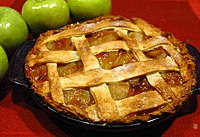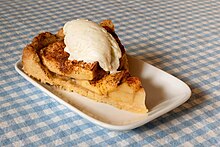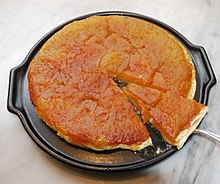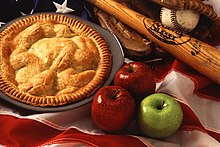  Apple pie with a lattice Apple pie with a lattice | |
| Place of origin | England |
|---|---|
| Serving temperature | Hot or cold |
| Main ingredients | Apples, flour, sugar, milk, cinnamon, butter, salt |
| Food energy (per 100 g serving) | 236 kcal (988 kJ) |
An apple pie is a pie in which the principal filling is apples. Apple pie is often served with whipped cream, ice cream ("apple pie à la mode"), custard or cheddar cheese. It is generally double-crusted, with pastry both above and below the filling; the upper crust may be solid or latticed (woven of crosswise strips). The bottom crust may be baked separately ("blind") to prevent it from getting soggy. Tarte Tatin is baked with the crust on top, but served with it on the bottom.
Originating in the 14th century in England, apple pie recipes are now a standard part of cuisines in many countries where apples grow. Apple pies are an unofficial symbol of the United States and one of its signature comfort foods.
Ingredients

Apple pie can be made with many different sorts of apples. The more popular cooking apples include Braeburn, Gala, Cortland, Bramley, Empire, Northern Spy, Granny Smith, and McIntosh. The fruit for the pie can be fresh, canned, or reconstituted from dried apples. Dried or preserved apples were originally substituted only at times when fresh fruit was unavailable. The basic ingredients of the filling are sugar, butter, a thickener like cornstarch and an acidic ingredient like lemon juice. Spices are added most commonly cinnamon, nutmeg. and lemon juice which is used to prevent oxidation of the apples when macerating the filling. Many older recipes call for honey in place of the then-expensive sugar.
Serving

Apple pie is often served à la mode, that is, topped with ice cream.
In another serving style, a piece of sharp cheddar cheese is placed on top of or alongside a slice of the finished pie. Apple pie with cheddar is popular in the American Midwest and New England, particularly in Vermont, where it is considered the state dish. In the north of England, Cheddar or Wensleydale cheese is often used.
Nutrition
| Nutritional value per 100 g (3.5 oz) | |||||||||||||||||||||||||||||||||||||||||||||||||
|---|---|---|---|---|---|---|---|---|---|---|---|---|---|---|---|---|---|---|---|---|---|---|---|---|---|---|---|---|---|---|---|---|---|---|---|---|---|---|---|---|---|---|---|---|---|---|---|---|---|
| Energy | 992 kJ (237 kcal) | ||||||||||||||||||||||||||||||||||||||||||||||||
| Carbohydrates | 34.0 g | ||||||||||||||||||||||||||||||||||||||||||||||||
| Sugars | 15.65 g | ||||||||||||||||||||||||||||||||||||||||||||||||
| Dietary fiber | 1.6 g | ||||||||||||||||||||||||||||||||||||||||||||||||
| Fat | 11.0 g | ||||||||||||||||||||||||||||||||||||||||||||||||
| Protein | 1.9 g | ||||||||||||||||||||||||||||||||||||||||||||||||
| |||||||||||||||||||||||||||||||||||||||||||||||||
| Other constituents | Quantity | ||||||||||||||||||||||||||||||||||||||||||||||||
| Water | 52.2 g | ||||||||||||||||||||||||||||||||||||||||||||||||
Link to USDA Database entry | |||||||||||||||||||||||||||||||||||||||||||||||||
| Percentages estimated using US recommendations for adults, except for potassium, which is estimated based on expert recommendation from the National Academies. | |||||||||||||||||||||||||||||||||||||||||||||||||
A commercially prepared apple pie is 52% water, 34% carbohydrates, 2% protein, and 11% fat (table). A 100-gram serving supplies 237 Calories and 13% of the US recommended Daily Value of sodium, with no other micronutrients in significant content (table).
English style

The 14th century recipe collection the Forme of Cury gives a recipe including good apples, good spices, figs, raisins and pears in a cofyn, a casing of pastry. Saffron colours the filling.
Lattice pastry styles were found from the 17th century along side the more traditional dome shapes lie crust . Modern English versions incorporate thick layers of sweetened slices of, usually, Bramley apple; layered into a dome shape to allow for downward shrinkage, and thus avoid a saggy middle; then topped with butter or lard shortcrust pastry; and baked until the apple filling is cooked.
In English-speaking countries, apple pie, often considered a comfort food, is a popular dessert, eaten hot or cold, on its own or with ice cream, double cream, or custard. Apple pies are often sold as mini versions in multipacks.
Dutch style


Recipes for Dutch apple pie go back to the Middle Ages. An early Dutch language cookbook from 1514, Een notabel boecxken van cokeryen ("A notable little cookery book"), letterpress printed in Brussels by Thomas van der Noot, who may also have been the author, documents a recipe for Appeltaerten (modern Dutch Appeltaarten 'apple pies'). This early recipe was simple, requiring only a standard pie crust, slices of especially soft apples with their skin and seeds removed, and den selven deeghe daer die taerte af ghemaect es (more of the same dough) on top. It was then baked in a typical Dutch oven. Once baked, the top crust (except at the edges) would be cut out from the middle, after which the apple slices were potentially put through a sieve before the pie was stirred with a wooden spoon. At this point the book recommends adding several spices to the pie, namely: cardamom, ginger, cinnamon, nutmeg, clove, mace and powdered sugar. Finally, after mixing the ingredients into the pie with cream, it is once again put into the oven to dry.
Traditional Dutch apple pie comes in two varieties, a crumb (appelkruimeltaart) and a lattice (appeltaart) style pie. Both recipes are distinct in that they typically call for flavourings of cinnamon and lemon juice to be added and differ in texture, not taste. Dutch apple pies may include ingredients such as full-cream butter, raisins and almond paste, in addition to ingredients such as apples and sugar, which they have in common with other recipes.
The basis of Dutch apple pie is a crust on the bottom and around the edges. This crust is then filled with pieces or slices of apple, usually a crisp and mildly tart variety such as Goudreinet or Elstar. Cinnamon and sugar are generally mixed in with the apple filling. Atop the filling, strands of dough cover the pie in a lattice holding the filling in place but keeping it visible or cover the pie with crumbs. It can be eaten warm or cold, sometimes with a dash of whipped cream or vanilla ice cream. In the US, "Dutch apple pie" refers specifically to the apple pie style with a crumb, streusel, topping.
French style
| This section does not cite any sources. Please help improve this section by adding citations to reliable sources. Unsourced material may be challenged and removed. (November 2020) (Learn how and when to remove this message) |

One kind of French style apple pie is very different compared to the typical version of the sweet dessert. Instead of it being right side up with crust on top and bottom, it actually is upside down, with the fruit being caramelised. This can be made not only with apples but other fruits or vegetables as well, for example, pears or tomatoes. See Tarte Tatin.
Others use a more traditional presentation, including variants like the Norman tart.
Swedish style
| This section does not cite any sources. Please help improve this section by adding citations to reliable sources. Unsourced material may be challenged and removed. (March 2023) (Learn how and when to remove this message) |
The Swedish style apple pie is predominantly a variety of apple crumble, rather than a traditional pastry pie. Often, breadcrumbs are used (wholly or partially) instead of flour, and sometimes rolled oats. It is usually flavoured with cinnamon and served with vanilla custard or ice cream. There is also a very popular version called äppelkaka (apple cake), which differs from the pie in that it is a sponge cake baked with fresh apple pieces in it.
In American culture
See also: List of American foods and Pie in American cuisine
Apple pie was brought to the colonies by the English, the Dutch, and the Swedes during the 17th and 18th centuries. Two recipes for apple pie appear in America's first cookbook, American Cookery by Amelia Simmons, which was published in 1796.What America's First Cookbook Says About Our Country and Its Cuisine
The apple pie had to wait for the planting of European varieties, brought across the Atlantic, to become fruit-bearing apple trees, to be selected for their cooking qualities as there were no native apples except crabapples, which yield very small and sour fruit. In the meantime, the colonists were more likely to make their pies, or "pasties", from meat, calling them coffins (meaning basket) rather than fruit; and the main use for apples, once they were available, was in cider. However, there are American apple pie recipes, both manuscript and printed, from the 18th century, and it has since become a very popular dessert. Apple varieties are usually propagated by grafting, as clones, but in the New World, planting from seeds was more popular, which quickly led to the development of hundreds of new native varieties.
Apple pie was a common food in 18th-century Delaware. As noted by the New Sweden historian Dr. Israel Acrelius in a letter: "Apple pie is used throughout the whole year, and when fresh Apples are no longer to be had, dried ones are used. It is the evening meal of children."
The mock apple pie, made from crackers, was probably invented for use aboard ships, as it was known to the British Royal Navy as early as 1812. The earliest known published recipes for mock apple pie date from the antebellum period of the 1850s. In the 1930s, and for many years afterwards, Ritz Crackers promoted a recipe for mock apple pie using its product, along with sugar and various spices.
Apple pie was one of the dishes that Rhode Island army officers ate for their Fourth of July celebrations during the Siege of Petersburg.
Although eaten in Europe since long before the European colonization of the Americas, apple pie as used in the phrase "as American as apple pie" describes something as being "typically American". In the nineteenth and twentieth centuries, apple pie became a symbol of American prosperity and national pride. A newspaper article published in 1902 declared that "No pie-eating people can be permanently vanquished." The dish was also commemorated in the phrase "for Mom and apple pie"—supposedly the stock answer of American soldiers in World War II, whenever journalists asked why they were going to war. Jack Holden and Frances Kay sang in their patriotic 1950 song "The Fiery Bear", creating contrast between this symbol of U.S. culture and the Russian bear of the Soviet Union:
- We love our baseball and apple pie
- We love our county fair
- We'll keep Old Glory waving high
- There's no place here for a bear
Advertisers exploited the patriotic connection in the 1970s with the commercial jingle "baseball, hot dogs, apple pie and Chevrolet".
One out of five Americans surveyed (19%) prefer apple pie over all others, followed by pumpkin (13%) and pecan (12%).
The unincorporated community of Pie Town, New Mexico, is named after apple pie.
See also
- Apple strudel (German Apfelstrudel), a large Austrian pastry made with apples, sugar and spices; similar to pie in that the filling is encased by the pastry, but it is rectangular rather than round and cut like coffee cake or stollen rather than like pie
- Apple turnover, similar to strudel but much smaller and triangular in shape, with a higher proportion of pastry to filling
- Apple cake
- Apple cobbler
- Applesauce cake
- List of apple dishes
- List of pies, tarts and flans
References
- Kat Eschner (12 May 2017). "Apple Pie Is Not All That American". The Smithsonian. Retrieved 29 March 2019.
- ^ "Apple Pie". Food Network.
- ^ Waters, Michael (13 July 2017). "The Long, Storied Controversy Over Cheese on Apple Pie". Atlas Obscura. Retrieved 11 June 2018.
- ^ D'Aiutolo, Olivia (17 August 2015). "A Pinch of History: Amelia Simmons's Apple Pie". Fondly, Pennsylvania. Historical Society of Pennsylvania. Retrieved 11 June 2018.
- "The Best Apples for Apple Pie". Farm Blog | The Stemilt Blog. 28 September 2015. Retrieved 21 December 2015.
- "7 Facts about Apple Pie". 13 March 2015.
- "An apple pie without the cheese". 2012 Apartment Therapy. Retrieved 14 June 2012.
- "Apple Pie". OChef. Retrieved 7 April 2012.
- "Product Highlight: Apple Pie, Sharp Cheddar, and A Nice Cup of Coffee". Hunger Mountain Coop. Archived from the original on 1 December 2016. Retrieved 7 April 2012.
- Catherine Donnelly, ed., The Oxford Companion to Cheese, ISBN 0199330905, 2016, p. 762
- Walter Gore Marshall, Through America Or, Nine Months in the United States, 1882 p. 99
- United States Food and Drug Administration (2024). "Daily Value on the Nutrition and Supplement Facts Labels". FDA. Archived from the original on 27 March 2024. Retrieved 28 March 2024.
- National Academies of Sciences, Engineering, and Medicine; Health and Medicine Division; Food and Nutrition Board; Committee to Review the Dietary Reference Intakes for Sodium and Potassium (2019). "Chapter 4: Potassium: Dietary Reference Intakes for Adequacy". In Oria, Maria; Harrison, Meghan; Stallings, Virginia A. (eds.). Dietary Reference Intakes for Sodium and Potassium. The National Academies Collection: Reports funded by National Institutes of Health. Washington, DC: National Academies Press (US). pp. 120–121. doi:10.17226/25353. ISBN 978-0-309-48834-1. PMID 30844154. Retrieved 5 December 2024.
- The Forme of Cury, section Servicium de Pissibus (i.e. fasting recipes), item XXIII
- Cooper, Joseph (1654). The art of cookery refined and augemented. British library.
- "Home Notabel Boecxken van Cokeryen door Thomas vander Noot (1514)". Kookhistorie.nl. 13 August 2002. Retrieved 5 November 2013.
- Een notabel boecxken van cokeryen - 123 Appeltaerten., dbnl.org
- "Recipe: More apple cakes: Hollandse appeltaart aka Dutch Apple Tart". Recipes Tap. Archived from the original on 12 October 2013. Retrieved 5 November 2013.
- "Dutch Apple Pie | Stemilt". Stemilt. 17 October 2016. Retrieved 15 November 2016.
- "page 21 "De verstandige kock of sorghvuldige huyshoudster (anno 1669)"". Retrieved 5 November 2013.
- "Dutch Apple Pie | Stemilt". Stemilt. 17 October 2016. Retrieved 27 October 2016.
- "Dutch Apple Pie". Brown Eyed Baker. Retrieved 5 November 2013.
- "Origin, History of cultivation". University of Georgia. Archived from the original on 21 January 2008. Retrieved 12 February 2013.
The center of diversity of the genus Malus is the eastern Turkey, southwestern Russia region of Asia Minor. Apples were improved through selection over a period of thousands of years by early farmers. Alexander the Great is credited with finding dwarfed apples in Asia Minor in 300 BC; those he brought back to Greece may well have been the progenitors of dwarfing rootstocks. Apples were brought to North America with colonists in the 1600s, and the first apple orchard on this continent was said to be near Boston in 1625.
- Fulton, April (19 June 2012). "Five Facts About Pie That Might Surprise You, And A Survey". NPR.
- "Apples in America". Archived from the original on 28 October 2012. Retrieved 2012-10-26.
- Stradley, Linda. "Apple Pie - History of Apple Pie". What's Cooking America.net. Archived from the original on 10 June 2011. Retrieved 2 July 2011.
- Clarke, James Stanier; Jones, Stephen; Jones, John (1812). "The Naval Chronicle". The Naval Chronicle. 28: 61. Retrieved 31 August 2016.
- Bliss (1850). Practical Cook Book: Containing Upwards of One Thousand Receipts... Lippincott, Grambo. p. 153. Retrieved 31 August 2016.
- Godey, Louis Antoine; Hale, Sarah Josepha Buell (1854). "Godey's Magazine". Godey's Magazine. 48–49: 378. Retrieved 31 August 2016.
- Kracklauer, Beth (28 February 2008). "Putting on the Ritz". Saveur.com. Retrieved 5 November 2013.
- "Food Timeline--Fourth of July food history". www.foodtimeline.org.
- "American food: The 50 greatest dishes". CNN Travel. 12 July 2017. Retrieved 5 November 2018.
- Cambridge University Press (2011). "Definition of "as American as apple pie"". Cambridge Advanced Learner's Dictionary & Thesaurus.
- "Popular Apple Sayings". U.S. Apple Association. Archived from the original on 1 July 2011. Retrieved 2 July 2011.
- "Fun facts" (PDF). piecouncil.org. Archived from the original (PDF) on 20 December 2016. Retrieved 7 November 2016.
- "Pie Town New Mexico". Pietown.com. Retrieved 5 November 2013.
External links
- Food Timeline history Notes: Apple Pie
- A Apple Pie, by Kate Greenaway, 1886. Woodblock printed children's book, based on a much earlier rhyme; from Project Gutenberg
- The Dutch Table: Dutch Apple Pie
- Dutch Apple Pie Recipe by Liesbeth de Vos
| English cuisine | |||||
|---|---|---|---|---|---|
| Roman times |
| ||||
| Middle Ages to 15th century |
| ||||
| 16th century |
| ||||
| 17th century |
| ||||
| 18th century |
| ||||
| 19th century |
| ||||
| 20th century |
| ||||
| 21st century |
| ||||
| Related | |||||
